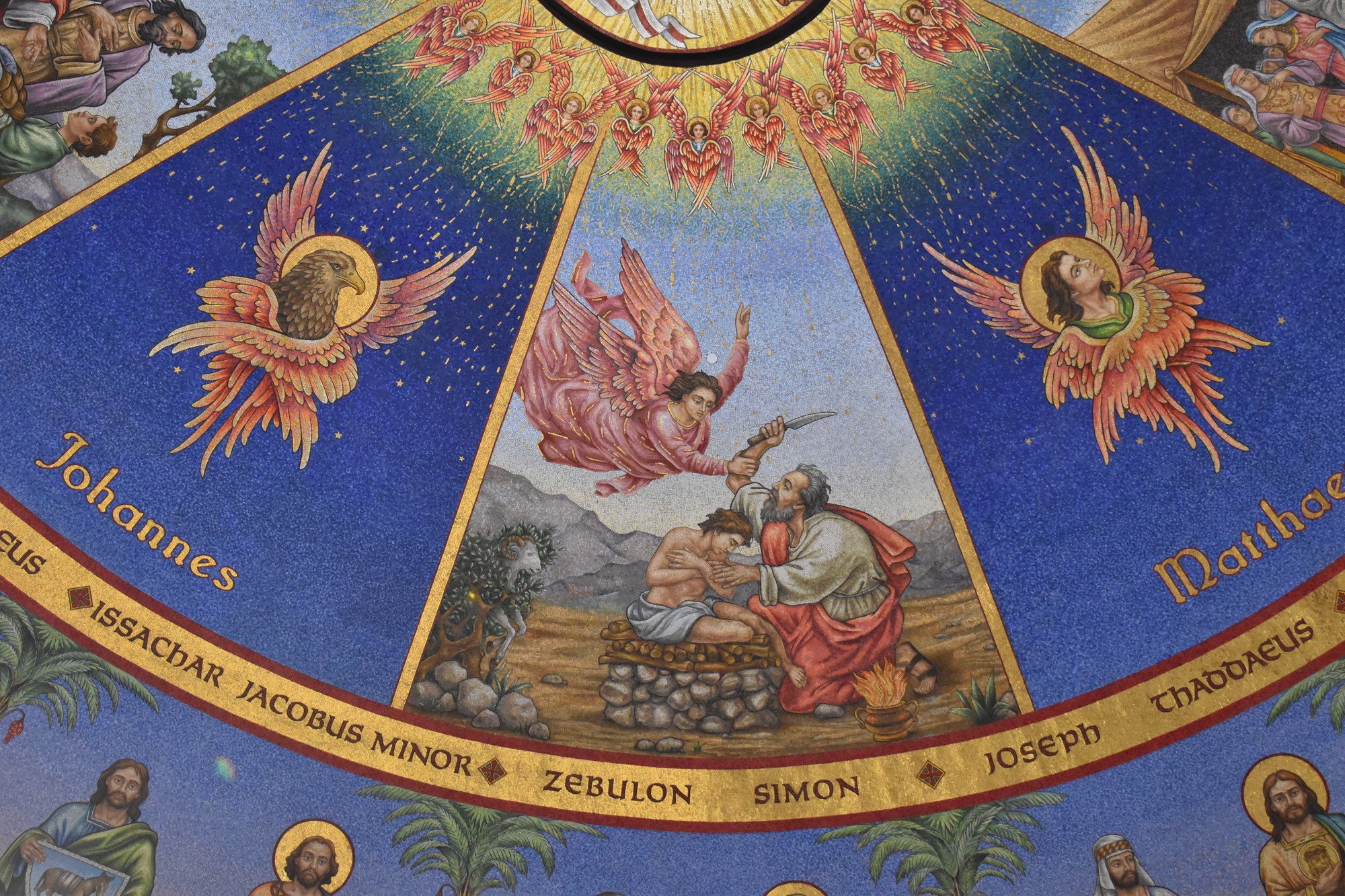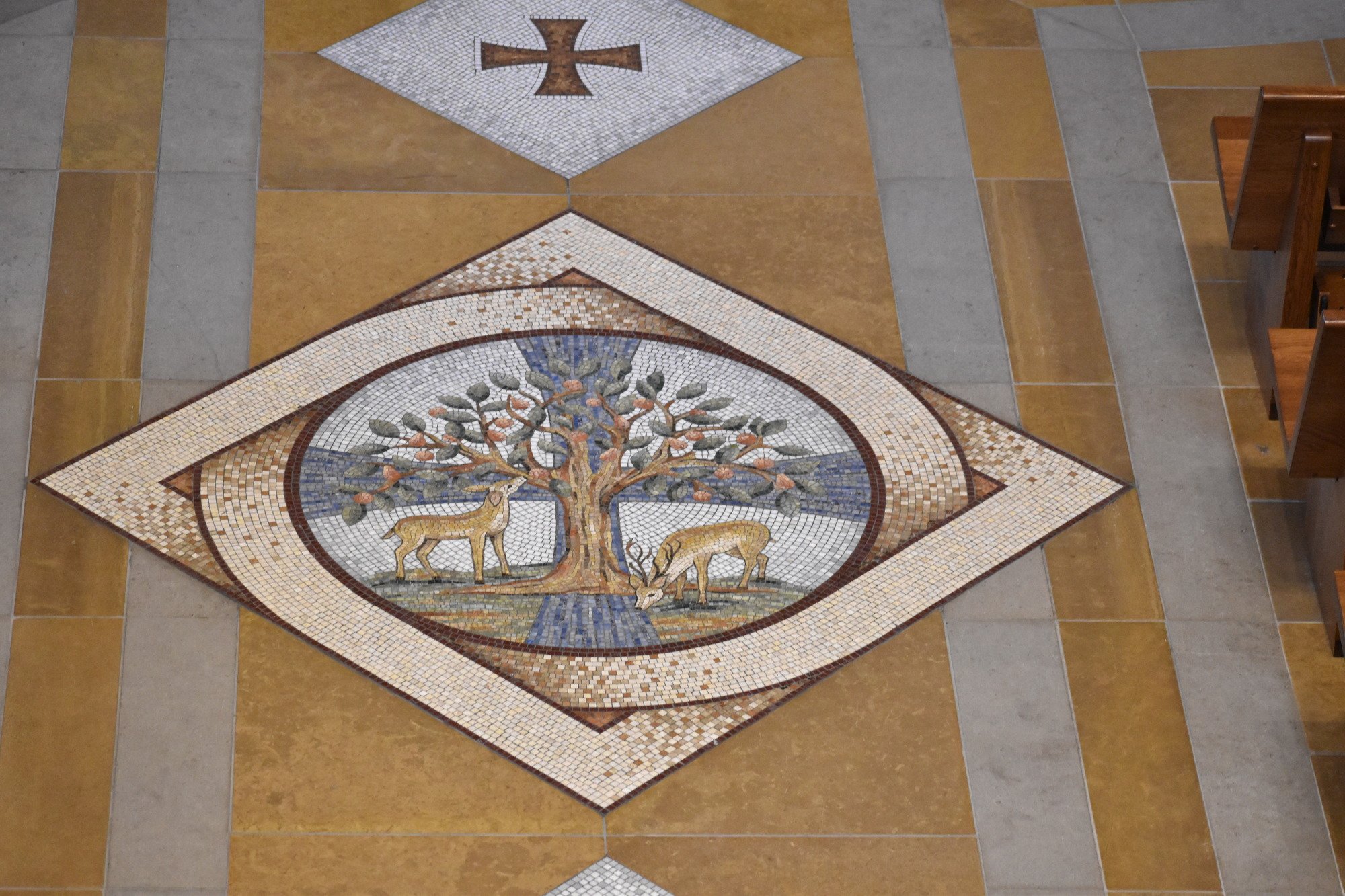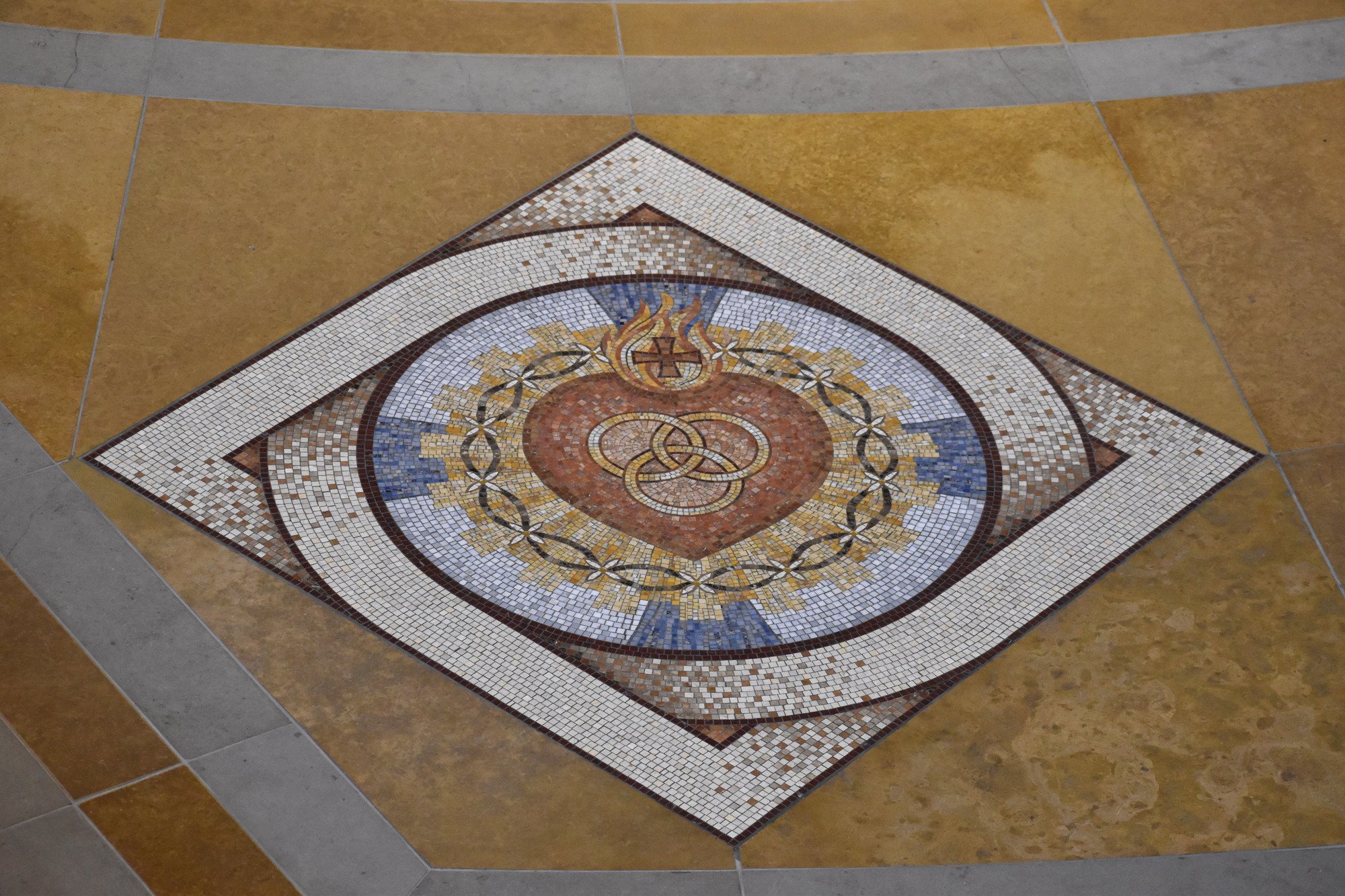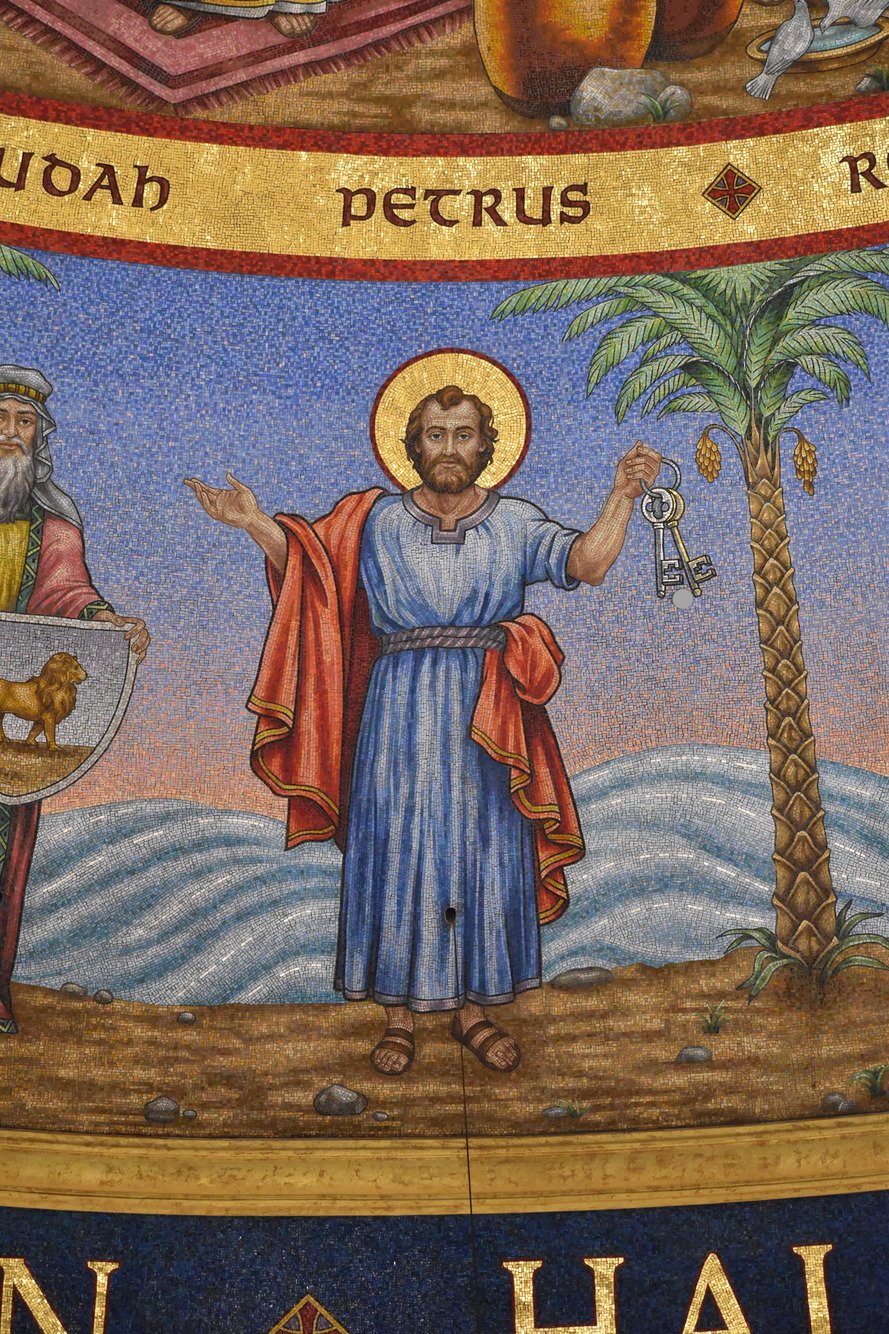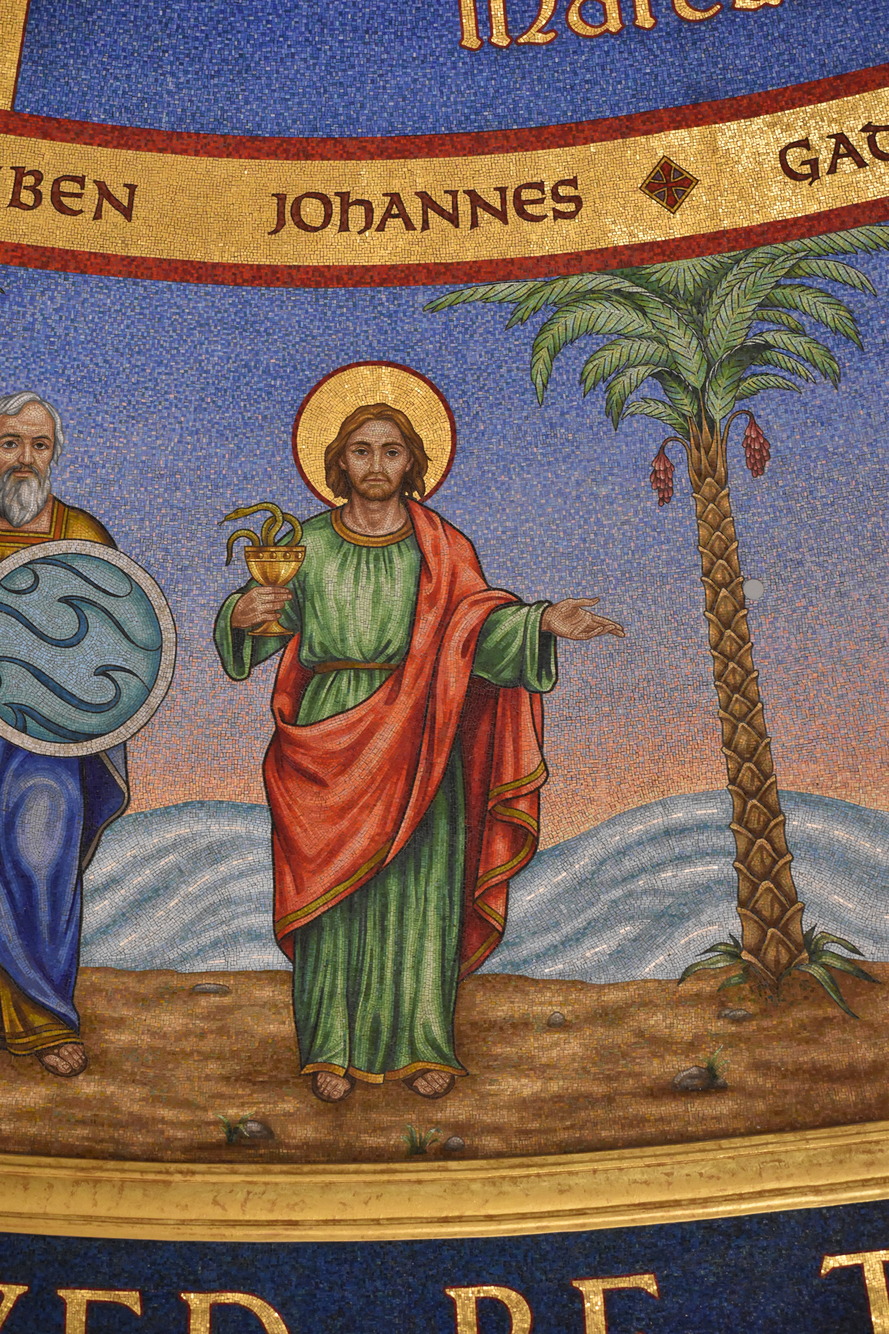Biblical Sources of the Imagery in the Dome
-
-
Bible stories from the dome
There are four stories represented in panels coming down from the center medallion where the victorious Lamb of God stands as if slain, positioned over the book with seven seals that only he is worthy to open (Revelation 5).
As St. Augustine says, “The New Testament is hidden in the Old, and the Old Testament is revealed in the New.” Each of these stories points us to the gift of the true presence of Christ in the Eucharist.The Sacrifice of Isaac
Genesis 22:1-14
God asks Abraham to sacrifice his only, beloved son, and then stops the sacrifice and provides a ram caught by its horns in a thicket for the sacrifice. Read the story to discover the parallels to Jesus’ crucifixion, except this time, the Lamb of God is already there.The Thanksgiving Offering of the Priest Melchizedek
Genesis 14:18-20
Hebrews 7
Melchizedek, a king and priest, brings bread and wine to bless Abraham after a military victory. His priesthood is fulfilled in Jesus’ priesthood, and the bread and wine are fulfilled in the forms of the Eucharist. The explanation in Hebrews shows that this understanding goes back to the very beginning of the Church.The Wedding at Cana
Jesus’ first public sign is changing six stone jars of water for ceremonial washing into wine during a wedding after they had run out. His mother, Mary, brings the situation to Jesus’ attention, leads him to the servants as she asks him to perform the miracle, and leaves, telling the servants, “Do whatever he tells you.”There are so many things to unpack and pray with in these verses. Here are a few for you to meditate on:
The wine is created from water that is used to purify the person washing with it, and the sign will be fulfilled in the purifying Blood of the Lamb that we receive in the Eucharist. There are at least 120 gallons of wine created. As we will see in the story of the loaves and fish, Jesus gives to us with extraordinary abundance.
Mary trusts that Jesus will take care of things and doesn’t worry about how. She leaves and tells the servants the same thing she tells us – “Do whatever he tells you.” Whatever it is, it will be perfect and best.
The sign is performed in the context of a wedding. The kingdom of heaven is portrayed often as a wedding, and we are all invited to the wedding feast of the Lamb.The miracle of the feeding of the 5,000 (or the miracle of the loaves and fishes)
John 6:1-14
After asking Philip where they should buy bread to feed the people who were coming to them, Jesus blesses five loaves of bread and two fish and feeds more than 5,000 people with twelve wicker baskets of bread leftover. Read the rest of John 6 to see how Jesus explains the connection between this sign and how the bread and wine of the Eucharist are transformed into his body and blood – “I am the living bread that came down from heaven; whoever eats this bread will live forever; and the bread that I will give is my flesh for the life of the world.”
The bread and wine become the body, blood, soul, and divinity of our Lord in the Eucharist, and we receive grace, mercy, and an intimate union with Jesus. As we saw in the story of the wedding at Cana, Jesus gives to us with extraordinary abundance.
-
-
-
One, Holy, Catholic, and Apostolic
In depth discussion and explanations of the Four Marks of the Church can be found in the Catechism of the Catholic Church, paragraphs 811-870
In depth discussion and explanations of the Cardinal and Theological Virtues can be found in the Catechism of the Catholic Church, paragraphs 1803-1829
Introduction to the Virtues
-
-
-
The Twelve Tribes of Israel
The dome is circled by alternating images of the twelve apostles and the twelve sons/tribes of Israel, the names of which are inscribed on the gates and foundation of the City of God. The names of each of the twelve tribes are inscribed on the twelve pearl gates of the City of God, and their placement in the dome is in the order they are listed in these verses.
Each of the sons of Israel holds a shield with the symbol of their tribe that is still in use today. The symbols come from Jacob’s final blessings for his sons in Genesis 49.
(Note: Jacob’s name was changed by God to Israel after he wrestled all night with an angel as he was preparing to reunite with his brother Essau – Genesis 32:23-29
Why is Dan missing?You may notice that one of the sons of Israel (Jacob) is missing from the Dome. The tribes in our dome are based on Revelation 7:5-8.
Dan was removed from the list of tribes because of apostasy. Ten of the twelve tribes of Israel rebelled against the kingdom of Judah, (1 Kings 12 1-24), and two golden calves were created and placed in a temple for worship in the land of Dan to replace the temple worship in Jerusalem. (1 Kings 12:26-29)
You would think they would learn after the first Golden Calf thing, wouldn’t you?
-
 BackForwardPauseCaption
BackForwardPauseCaption
-
Twelve tribes continued...
Several of the symbols of the tribes of Israel refer to a specific event recorded in Scripture.
Reuben was the oldest of Israel’s sons, but not given the inheritance of Jacob because he slept with Jacob’s concubine. (Genesis 35:22)
Simeon and Levi were next in line, but also lost the inheritance because they slaughtered a town in their fury over the rape of their sister, Dinah. (Genesis 34)
The tribe of Levi was named as priests of God because of their defense of God’s honor when the Israelites worshipped the Golden Calf as Moses was receiving the Ten Commandments. (Exodus 32).
The breast piece that Levi carries is the ephah that the high priest wears as he enters the holy of holies and represents each of the twelve tribes of Israel. (Exodus 28:29)
Joseph had a dream about eleven sheaves of wheat bowing down to his sheaf (Genesis 37:5-7) that started a long chain of events, including his brothers trying to kill him, his being sold into slavery, being sent to prison, and finally becoming the second in command of Egypt, leading to the fulfillment of the dream as his brothers unknowingly came to him to beg for food during a famine (Genesis 37-45).
The tribe of Benjamin was known for being fierce warriors. The entire tribe would train to fight left-handed in order to gain an unexpected advantage as seen in these stories:
Judges 3:15-21
Judges 20:16
1 Chronicles 12:2
Mannasseh’s symbol of arrows and olive branches represents a choice given to the Israelites as they entered the Promised Land. We are given the same choice today – a blessing for obeying the commandments of the Lord, and a curse for turning away. (Deuteronomy 11:26-28)
Interestingly, the Great Seal of the United States includes arrows and olive branches in the talons of an eagle, referencing these verses.
-
-
-
The Twelve Apostles
The dome is circled by alternating images of the twelve apostles and the twelve sons/tribes of Israel, the names of which are inscribed on the gates and foundation of the City of God. The Twelve Apostles are listed in order of their appearance in Acts 1:13-26, after Judas has been replaced by Bartholomew.
Each apostle carries an item that represents the way they were martyred and/or something related to their lives (i.e. Peter holds the Keys to the Kingdom (Matthew 16:14-19), and John holds a chalice of snakes representing his drinking poisoned wine and miraculously surviving)
-
-
-
The beauty is in the detailsA brief summary of the Mosaic Dome at St. John NeumannCenter
- Lamb of God surrounded by 12 Seraphim (six-wings) and 12 Cherubim (four-wings)
- The four Gospel Evangelists (Matthew, Mark, Luke, and John) and their figures-
- The New Testement
- Miracle of the Loaves and Fishes
- The Wedding at Cana
- Old Testament
- Sacrifice of Isaac, son of Abraham
- Sacrifice of Melchizedek
- The 12 Apostles
- The 12 Tribes of Israel
- The Lord's Prayer
- Uman: One
- Sanctum: Holy
- Catholicam: Catholic
- Apostolicam: Apostolic
-
-
-
OUR DOME IN REVIEW:
THRONE OF GOD
The 72-foot tall dome of gold and colored Italian smalti mosaic tile depicts the heavenly Kingdom of God. The Lamb of God, the seraphim and cherubim surrounded by a halo as brilliant as an emerald, the four evangelists, and the four Eucharistic scenes, give us a glimpse of the throne of God.
THE VICTORIOUS LAMB once slain, is standing on the scroll and the seven seals. He is surrounded by the seraphim and cherubim who, day and night, sing out in glory and praise to God.
THE FOUR EVANGELISTS emanate from the center to form a cross. These four seraphim resemble a face like that of a human being, a lion, a calf (ox), and an eagle in flight. They represent the four gospels – Matthew, Mark, Luke, and John – the Word of God – the light that penetrates the darkness and brings life to the world.
THE FOUR PREFIGURATIONS OF THE EUCHARIST
portrayed in the middle ring, foreshadow the Mass, which is the unbloody sacrifice of the cross. The two Old Testament scenes are the offering of the bread and wine by Melchizedek and the sacrifice of Isaac by Abraham. The two New Testament scenes are the wedding at Cana and the multiplication of the loaves.THE CITY OF GOD
The theology depicted in the lower ring of the dome represents the holy city, the new Jerusalem, (the bride of the Lamb) coming down out of heaven from God. The city gleamed with the splendor of God. Its radiance was like that of a precious stone, like jasper, clear as crystal. The city was decorated with pure gold, every precious stone, and pearls. The names of the twelve tribes of Israel were inscribed on the twelve pearl gates. The names of the twelve apostles of the Lamb were inscribed on the city’s jeweled foundation. The river of life-giving water, sparkling like crystal, flows from the throne of God and of the Lamb. On either side of the river grew the tree of life that produces fruit twelve times a year, once each month; the leaves of the trees serve as medicine for the nations.
From Christ’s teachings on the Sermon on the Mount, the LORD’S PRAYER encircles the ring below and continues at the Tabernacle and confessionals giving glory to God the Father throughout the Church.
In the PENDENTIVES four powerful angels support the dome each holding a scroll that names the four marks of the Church as UNAM (ONE), SANCTUM (HOLY), CATHOLICAM (CATHOLIC) and APOSTOLICAM (APOSTOLIC). We profess this belief in the Nicene Creed at Mass.
-
